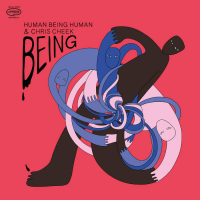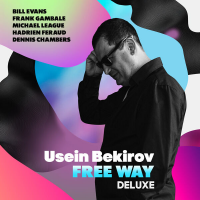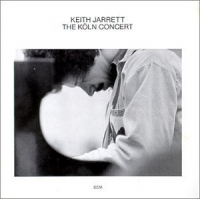Home » Jazz Articles » Album Review » Frank Kimbrough: Monk's Dreams: The Complete Composition...
Frank Kimbrough: Monk's Dreams: The Complete Compositions of Thelonious Sphere Monk
In such a context, pianist Frank Kimbrough, a long time follower of Monk, assembled a stellar quartet of saxophonist/trumpeter Scott Robinson, bassist Rufus Reid, and drummer Billy Drummond to perform sets of Monk tunes at the Jazz Standard and Kitano clubs in New York. One of the listeners was Maitland Jones, who has for years run a wonderful series of Princeton Jazz Nights, making superb choices of musicians to perform in relaxed settings at people's residences. He suggested to Kimbrough that the group record all of Monk's tunes. He became one of the producers of this boxed set of six CDs in which the group recorded 70 songs, most or all of Monk's published legacy. There are some pieces not on the album that Monk made up on the spot, such as the amazing "Chordially" from the The London Collection: Volume Three (Black Lion Records, 1971.) A Monk scholar might also identify some written compositions that never got published.
One has to ask, what is the purpose of putting all of Monk's tunes in a single boxed set by a current group? They were all recorded by Monk, sometimes several times over, so why should musicians not particularly associated with Monk take up such a challenge? For the musicians themselves, the simple answer is, "It's fun, and it works!" Kimbrough, although not necessarily known as a Monk-o-phile, has been studying and playing Monk for decades. So why not? And if not now—in tribute to the centennial year—when?
Then too, no one has ever put Monk's tunes all in one place for easy access. They're spread over dozens of recordings and other musicians and vocalists have covered them thousands of times. But it is good to have them all in one place, where you can hear them back-to-back. The boxed set thus provides a ready reference work that becomes a point of convergence for all that came before and will arise in the future. And it also serves as a fine illustration and compendium of how musicians can take inspiration from a distinct style not their own and maintain the original intent while making it their own. Moreover, just as you can enjoy an evening of listening to all of George Gershwin's, Cole Porter's, or Richard Rodgers' tunes, Kimbrough and his group make it surprisingly pleasurable to listen to Monk, despite the latter's iconoclastic way of syncopation and melodic inflections. To paraphrase a song, "All of Monk, why not take all of Monk?"
Overall, this project and product, with fine sound quality and musicianship, packaging, and informative liner notes by revered critic Nate Chinen, is top notch. However, opinions are going to differ on whether it does justice to Monk. It's hard to know just what that means, but everyone seems to have his own ideas about it, and this recording is attempting to be definitive. Perhaps it "gets" Monk enough to be acceptable but does not make it all the way there. Kimbrough "channels" Monk's playing, but his touch on the piano is more gentle and careful on the keys than Monk and lacks the latter's ferocity.
Robinson, Reid, and Drummond capture a lot of Monk's phrasing and syncopation, but they are obviously more comfortable with bebop and hard bop modalities. That's all right, because many of Monk's sidemen swung, and a defining characteristic of his groups was the mixture of Monk'a quirky kind of stride rhythm while his sidemen played straight ahead. But there are times when Kimbrough and company appear to be struggling to come up with ideas, and Robinson's periodic squeaks and squawks are a vain attempt to insert Monk into his improvisations. However, his artful use of the low registers of the bass saxophone and other reed instruments (bass clarinet and contrabass sarrusophone) inject an irony and humor that is quintessentially Monk.
Some of the limitations of the improvising comes from the fact that each track is relatively brief, four to six minutes long, and it usually takes a band that long to just warm up to a tune and begin to go out on a limb. Nevertheless, they develop some imaginative ideas, and there is plenty to keep the listener's interest. Still, few if any of their renditions will be regarded as a truly memorable cover of a Monk tune.
An overview of some of the many tracks in this compendium will illustrate and elaborate some of these points. They are reviewed in order of their appearance within the corpus of six discs.
The first tune in the collection, "Thelonious," is appropriately done in a swing version with Monk's piano style virtually cloned by Kimbrough. Unfortunately, Robinson switches between trumpet and tenor saxophone, which takes his attention from what he can do musically, and somehow his use of the upper registers on tenor sax also distracts from the Monk idiom. Kimbrough, however, steps up firmly to the Monk style and lends some excitement.
"Ba-Lue Bolivar Ba-Lues-Are" is a Monk masterpiece, and Robinson does better on the lower tenor sax register in stating the theme. His tenor sax playing naturally invites a comparison with Sonny Rollins and Ernie Henry on Monk's Brilliant Corners (Riverside, 1956). Monk's playing on that recording comes through like a magnifying glass of his sophistication with rhythmic complexities. Over half a century later, Rufus Reid's playful bass walk captures the Monk feeling to a "t."
"Ask Me Now" begins with a melancholy saxophone wail leading up to the plaintive melody that could have been written (but was not) by Tadd Dameron. There is no attempt to imitate Monk here, which is all to the good. Instead, Robinson follows the emphasis on the lyrics and emotions in the manner of Lester Young and Ben Webster. Kimbrough follows suit on piano. Monk's ballads can be haunting, and this version is definitely so.
"Bemsha Swing" is a funky melody, delightfully delivered by Robinson's bass saxophone. Interestingly, Kimbrough layers on the melody with a slight delay, which is a very Monk-ish thing to do. This track is one of the truest to Monk's genius, which was to expand possibilities through paradox.
"Cepuscule with Nellie" (i.e. twilight with Monk's wife) has Kimbrough artfully capturing Monk's playing. On "Think of One," the ensemble especially gets the precision and feel of the superb Monk quartet with Charlie Rouse, Larry Gales, and Ben Riley. "Eronel" is simply one of those great Monk tunes and the group traverses it beautifully, including a subito pianissimo solo by saxophone with drums a la tap dance that is one of a kind.
"Ruby My Dear" is one of the greatest ballads ever written, with its subtle inflections and implied key changes. Here, it's done as a duet with Robinson performing beautifully on tenor sax accompanied by Kimbrough's piano. "I Mean You" is a great Monk "standard" with a nicely done solo by Robinson echoing Paul Desmond. Kimbrough delivers a fine piano solo with well-executed Monk inflections and complexities
The collection's title tune, "Monk's Dream," is carried through straight ahead. Robinson's sax solo has a bebop feel, perhaps with a nod to Phil Woods, one of the first saxophonists to work with Monk. Drummond carries the piece forward with just the right rhythmic propulsion.
The theme of "Brilliant Corners" is stated by bass saxophone and piano and then recurs in double time. Robinson's bass sax solo catches Monk without imitating him, and Kimbrough does the same on piano. Here we find some of the best, most intelligent improvising in the whole collection.
The final tune of the last disc, "Epistrophy" is a great test of how far out a group is willing to venture. This group prefers to stay close to the shore. Robinson's bass saxophone states the melody with Kimbrough providing a rhythmic motif, then nicely breaks out into the familiar refrain. However. genuine originality is achieved with Drummond's complex Monk-like rhythms.
These musicians are to be congratulated for taking on the daunting task of recording all of Monk in back-to-back sessions, which were done at Maggie's Farm studio in eastern Pennsylvania. The engineer, Matt Balitsaris, captured the sound cleanly, without gimmicks, which Monk always appreciated. Mait Jones and his associate, Dorothy Lieberman, did great service in conceiving the project and supporting it throughout. On the whole, despite its limitations, this is a serious musical accomplishment. But the truth is that no one can recapture the excitement, originality, and creativity of the original Monk recordings. One must always return to them.
Track Listing
CD 1: Thelonious; Light Blue; Played Twice; Ba-Lue Bolivar Ba-Lues-Are; Ask Me Now; Humph; Bright Mississippi; Reflections; Bemsha Swing; Teo; Blue Sphere.
CD 2: Crepuscule with Nellie; Think of One; 52nd St. Theme; Eronel; Bluehawk; Little Rootie Tootie; Two Timer; Ruby, My Dear; Boo Boo's Birthday; San Francisco Holiday; Functional; I Mean You.
CD 3: Shuffle Boil; Monk's Dream; Evidence; Misterioso; Four in One; Brake's Sake; Pannonica; Bye-Ya; North on the Sunset; Introspection; We See; In Walked Bud.
CD 4: Nutty; Trinkle Tinkle; Blues Five Spot; Round Midnight; Jackie-Ing; Well You Needn't; Sixteen; Locomotive; Gallop's Gallop; Children's Song; Blue Monk; Friday the 13th.
CD5: Criss Cross; Raise Four; Let's Call This; Who Knows; A Merrier Christmas; Stuffy Turkey; Monk’s Point; Work; Brilliant Corners; Off Minor; Hackensack; Oska T.
CD 6: Let’s Cool One; Hornin’ In; Coming on the Hudson; Straight No Chaser; Monk’s Mood; Green Chimneys; Rhythm-A-Ning; Ugly Beauty; Skippy; Something in Blue; Epistrophy.
Personnel
Frank Kimbrough
pianoScott Robinson
saxophone, tenorRufus Reid
bass, acousticBilly Drummond
drumsAlbum information
Title: Monk's Dreams: The Complete Compositions of Thelonious Sphere Monk | Year Released: 2018 | Record Label: Sunnyside Records
Tags
PREVIOUS / NEXT
Support All About Jazz
 All About Jazz has been a pillar of jazz since 1995, championing it as an art form and, more importantly, supporting the musicians who make it. Our enduring commitment has made "AAJ" one of the most culturally important websites of its kind, read by hundreds of thousands of fans, musicians and industry figures every month.
All About Jazz has been a pillar of jazz since 1995, championing it as an art form and, more importantly, supporting the musicians who make it. Our enduring commitment has made "AAJ" one of the most culturally important websites of its kind, read by hundreds of thousands of fans, musicians and industry figures every month.

























